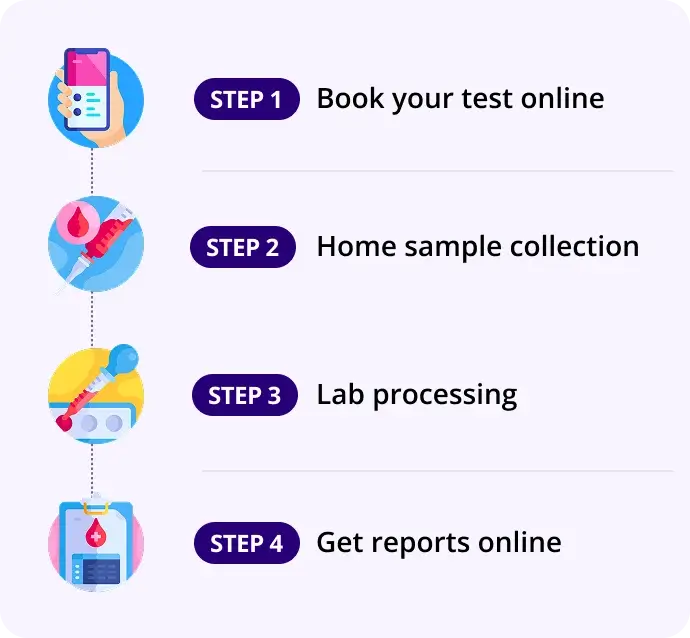Anti Hepatitis C Virus (HCV) - Total
Unit Test
Report in 20Hrs
At Home
No Fasting Required
Details
The Anti-HCV Total test detects both IgM and IgG antibodies produced by the immune system in response to infection by the Hepatitis C virus
₹199₹935
79% OFF
Anti Hepatitis C Virus (HCV) - Total
- Anti Hepatitis C Virus (HCV) - Total
- Why is it done?
- Detects antibodies produced in response to hepatitis C virus infection to determine if an individual has been exposed to or infected with HCV
- Primary screening test used in patients with suspected hepatitis C or those at risk for HCV exposure
- Routine screening for blood and organ donors, healthcare workers, and patients with liver disease
- Evaluation of patients with unexplained elevated liver enzymes or chronic liver disease
- Assessment in patients with risk factors including history of intravenous drug use, sexual exposure to HCV-positive individuals, or occupational exposure
- Monitoring and confirmation following a positive rapid HCV test or exposure incident
- Normal Range
- Negative Result: No detectable anti-HCV antibodies; typically reported as "Negative", "Non-reactive", or "Not detected"
- Positive Result: Anti-HCV antibodies detected; typically reported as "Positive", "Reactive", or as a numerical value (S/CO or sample-to-cutoff ratio > 1.0)
- Units: S/CO (Sample-to-Cutoff ratio) for quantitative results, or qualitative as Positive/Negative
- Interpretation: Negative indicates no prior exposure to HCV or absence of infection. Positive indicates exposure to HCV and requires confirmatory testing
- Interpretation
- Negative Result: No evidence of HCV infection or exposure. However, results may be negative during early infection (window period of 1-10 weeks before antibodies develop)
- Positive Result: Indicates past or present HCV infection; confirms exposure to the virus. Does not differentiate between active infection and cleared infection (spontaneous or treatment-induced)
- Borderline/Equivocal Result: Result near cutoff value; requires repeat testing or confirmatory test (HCV RNA by PCR, recombinant immunoblot assay, or supplemental antibody test)
- Factors Affecting Results: Early infection (window period), immunocompromised states (may have false negatives), chronic kidney disease patients on hemodialysis, and liver transplant recipients
- Clinical Significance: Positive anti-HCV antibodies warrant HCV RNA PCR testing to determine if active infection is present and to assess viral load for treatment decisions
- Associated Organs
- Primary Organ: Liver - HCV directly infects and replicates within hepatocytes, causing inflammation and potential cirrhosis
- Associated Conditions: Chronic hepatitis C, cirrhosis, hepatocellular carcinoma, fatty liver disease, portal hypertension, esophageal varices
- Extrahepatic Manifestations: Cryoglobulinemia, glomerulonephritis, autoimmune thyroiditis, B-cell lymphoma, vasculitis, and peripheral neuropathy
- Complications: Liver failure, variceal bleeding, ascites, hepatic encephalopathy, renal dysfunction, and increased risk of infection
- Follow-up Tests
- Confirmatory Testing (if Positive): HCV RNA PCR (qualitative and/or quantitative) to confirm active infection and determine viral load
- HCV Genotyping: Determine HCV strain to guide treatment decisions and predict treatment response
- Liver Function Tests: AST, ALT, alkaline phosphatase, bilirubin, albumin to assess liver injury and synthetic function
- Liver Fibrosis Assessment: FIB-4 index, AST-to-platelet ratio index (APRI), transient elastography (FibroScan), or liver biopsy to stage fibrosis
- HCV Core Antigen: May be used as alternative confirmatory test or for monitoring viral replication
- Hepatitis A and B Serology: Screen for co-infections with other hepatitis viruses
- HIV and Human T-cell Leukemia Virus (HTLV) Testing: Screen for concurrent blood-borne infections in at-risk patients
- Post-Treatment Monitoring: HCV RNA PCR at 12 weeks after completion of direct-acting antiviral therapy (SVR12) or 24 weeks (SVR24) to confirm viral clearance
- Fasting Required?
- Fasting: No
- Special Instructions: No fasting is required for this test. Patient may eat and drink normally. Blood can be drawn at any time of day
- Medications: No medications need to be withheld for this test; all regular medications may be taken as prescribed
- Specimen Collection: Standard venipuncture with serum separator tube (SST) or equivalent collection tube; approximately 5-10 mL of blood
- Pre-Test Preparation: No specific preparation needed; patient should remain seated for 5 minutes before blood draw to ensure proper blood pressure and fluid distribution
- Why is it done?
How our test process works!

